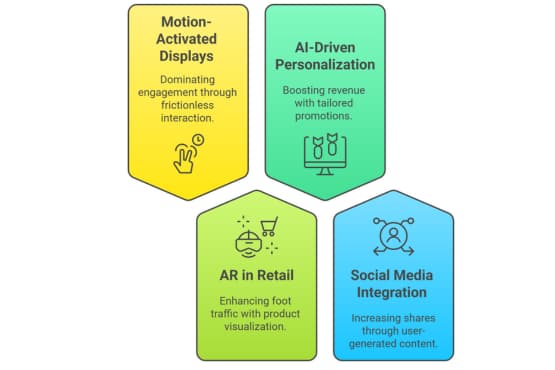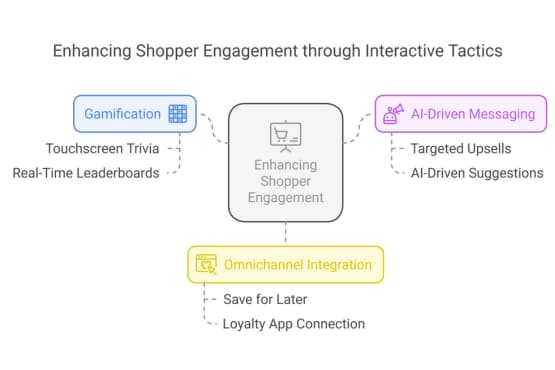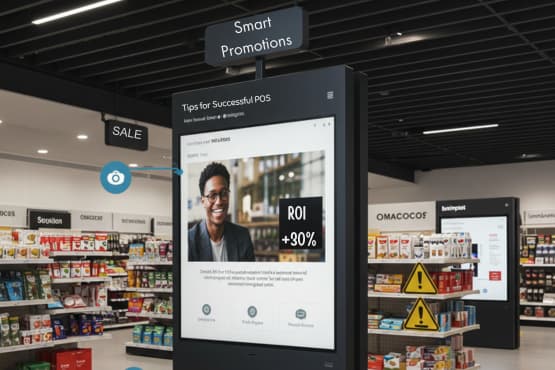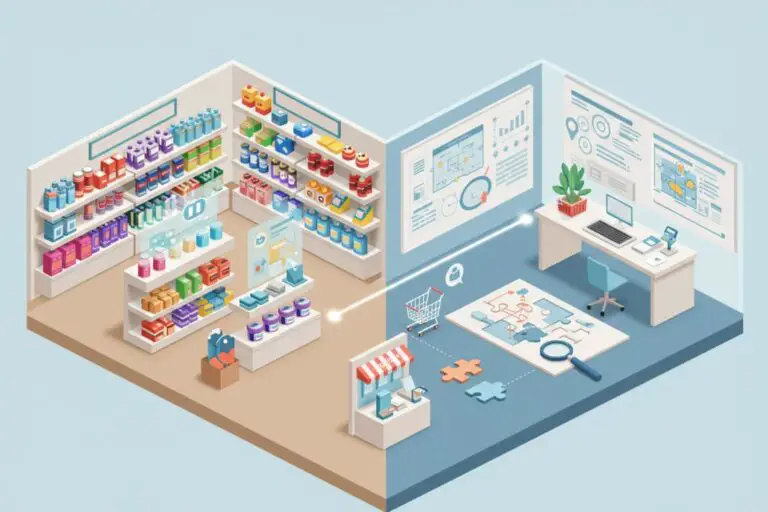You’re browsing in a store, and as you walk past a display, it lights up, greeting you by name. It suggests a product based on your last visit and even offers you a discount if you purchase now. Would you engage? Welcome to the future of retail.
In 2025, interactive POS displays are turning passive window shoppers into engaged buyers using AI, motion sensors, and AR-driven experiences. These high-tech displays generate 14x more engagement than QR codes alone.
Many retailers struggle with engagement drop-offs. Static displays lack appeal, and QR codes often go ignored. The solution? AI-powered and motion-activated displays that turn passive browsing into real-time interaction.
As a former head of trade marketing with over a decade of experience, I’ve seen firsthand how implementing interactive POS can transform the shopping experience. Retailers I’ve worked with report that switching from static posters to motion-activated displays increased shopper dwell time by 40%, while reducing customer decision fatigue.
One store saw an immediate 20% increase in impulse purchases after implementing AI-powered POS recommendations.
In this guide, we’ll explore the proven strategies retailers are using to transform the point of sale into a profit-driving engagement hub. With retailers using interactive displays seeing a 15-30% sales increase, it’s clear that the shift towards interactivity is not just a trend—it’s a necessity.
Why Interactive POS Displays Dominate Retail Engagement
Gone are the days when a simple poster or product demo sufficed to capture shoppers’ attention. Today’s consumers demand more—they crave experiences that are engaging, personalized, and memorable. This is where interactive POS displays come into play.
By incorporating dynamic elements such as LED screens, touchscreen kiosks, and gamified interfaces, retailers can create immersive experiences that shoppers can’t resist. The data speaks for itself:
| Feature | Static Displays | Interactive POS |
|---|---|---|
| Engagement | Low | 14x higher (motion-activated) |
| Conversion Rates | ~2% | 12-30% increase |
| Time Spent | Short | 40% increase |
🛍️ Touchscreen Kiosks: 16x More Engaging than QR Codes!
- Touchscreen kiosks generate 348 engagements per location vs. QR codes at just 21.
- It’s no wonder retailers across industries are eager to embrace this technology and reap the rewards.
2025 Trends Shaping Interactive POS Marketing
As we look ahead to 2025, several key trends are shaping the landscape of interactive POS displays.
Let’s take a closer look at some of the most impactful developments and why they matter:

1. Motion-Activated Displays Dominate (14x More Engagement)
- Why? Eliminates friction compared to QR codes.
- Example: POS Interactive’s sensor tables boosted shopper dwell time by 40%.
2. AR in Retail (Boosts Foot Traffic by 25%)
- Why? Shoppers can visualize products before purchase.
- Example: Lloyd Shoes saw 25% more store visits after implementing AR displays.
3. AI-Driven Personalization (12% Revenue Lift)
- Why? AI adapts promotions based on customer preferences.
- Example: Smart POS displays show dynamic discounts based on real-time shopping behavior.
🚀 Retailer Struggle: One mid-sized grocery chain I consulted for struggled with engagement drop-off at self-checkout stations. By installing AI-powered suggestive selling displays, they increased high-margin impulse purchases by 22% within 3 months.
4. Social Media & UGC Integration (200% More Shares)
- Why? Brands leveraging UGC see higher engagement and trust.
- Example: Beverage brands with interactive sampling stations saw 200% more social media shares.
Actionable Tactics to Elevate Shopper Interaction
Now that we’ve explored the trends driving the future of interactive POS displays, let’s dive into some concrete tactics you can implement to enhance shopper engagement and boost sales.

1. Gamification at the Point of Sale
Gamification is a powerful tool for capturing shoppers’ attention and driving interaction. Incorporate elements beyond just spin-to-win discounts:
- 🎮 Touchscreen Trivia: Challenge shoppers to answer questions about products for instant coupons.
- 🏆 Real-Time Leaderboards: Display top scores or fastest completion times to encourage competitive engagement.
- Example: Snack aisle kiosks with trivia games increased coupon redemption by 50%.
2. Hyper-Personalized AI-Driven Messaging
AI-driven POS displays can deliver hyper-personalized messaging that resonates with each shopper. But generic “context-aware promotions” aren’t enough:
- 🎯 Targeted Upsells: Leverage AI to show upsells and cross-sells based on the shopper’s real-time behavior and past purchases.
- 🛒 AI-Driven Upsells at Checkout → +18% More Sales!
- AI-powered product suggestions at self-checkout kiosks boosted upsell rates by 18% in QSRs.
- Retailer Tip: Use AI to promote bundle offers or last-minute add-ons during checkout!
3. Seamless Omnichannel Integration
The modern shopping journey bridges online and offline interactions. Interactive POS displays play a crucial role in facilitating this omnichannel experience:
- 📱 Save for Later: Use QR codes to let shoppers save items to a digital wishlist or instantly access more product info on their phone.
- Example: Retailers who connect POS displays to their loyalty apps and allow “save for later” see higher repeat purchase rates.
Real-World Success Stories
Let’s look at how leading brands are implementing interactive POS displays and the results they’re achieving:
| Brand | What They Did | The Results |
|---|---|---|
| Nike | In-store screens for custom sneaker designs | +30% dwell time, +12% sales |
| Coca-Cola | Gamified, UGC-integrated vending machines | +20% sales, +50% social engagement |
| Sephora | AR-powered virtual try-on kiosks | 4x conversion vs. static displays |
📌 Nike’s Custom Sneaker Display – Driving Engagement & Sales Nike implemented interactive touchscreen kiosks in flagship stores, allowing customers to customize sneaker colors and designs in real time.
- Before: Customers could only browse in-store stock or use a static website.
- After: The digital displays increased dwell time by 30% and boosted custom sneaker sales by 12%.
- Why It Worked: Personalization, real-time interactivity, and social media shareability.
These examples show the tangible impact of well-executed interactive POS displays on key metrics like dwell time, sales, and social engagement. By taking cues from these industry leaders, you can craft your own winning strategy.
Avoiding Common Pitfalls
While interactive POS displays offer tremendous potential, some retailers make critical missteps in implementation.
Here are pitfalls to avoid:

❌ Overloading Content
- POS Interactive found cluttered screens reduce engagement by 25%.
- ✅ Fix: Use short videos, simple messaging, and auto-rotating promos.
❌ Static Campaigns
- Stores rotating digital promos weekly see 2x engagement vs. static displays.
- ✅ Fix: Regularly refresh content and run time-sensitive, dynamic promotions.
❌ Ignoring Analytics
✅ Fix: Religiously track metrics like engagement rates, dwell times, and conversions to optimize display placement and content.
FAQs on Interactive POS Displays
Q: How much do interactive POS displays cost?
Prices vary based on features and customization. Basic touchscreen kiosks start at $500, while AI-powered, cloud-connected POS displays range from $3,000-$10,000 per unit.
Q: What’s the ROI of interactive POS Marketing?
Stores using AI-powered displays see a 12% revenue boost, while motion-activated displays increase engagement 14x over traditional signage.
Q: Are interactive displays better than Digital ads?
Yes! In-store interactive displays capture 10% more recall than digital ads and influence impulse purchases by 30% more.
Q: Are interactive POS displays worth it for Small businesses?
Absolutely! Small retailers see a 15-25% sales uplift using interactive displays. Budget-friendly options include entry-level motion-sensor signage . ROI is typically achieved in 6-12 months.
Q: What’s the maintenance cost of AI-powered displays?
Most cloud-connected POS displays require minimal upkeep. Software updates and content changes can be managed remotely, reducing labor costs. Annual maintenance averages $100-$500 per unit.
Conclusion
interactive POS displays aren’t just a nice-to-have – they’re essential for retailers serious about driving shopper engagement and sales. The key strategies to focus on:
- Harness smart tech like IoT sensors and cloud-based systems for real-time optimization.
- Use AR to create immersive product experiences and reduce return rates.
- Incorporate gamification to drive interaction and product discovery.
- Deliver AI-powered hyper-personalization based on shopper behavior.
- Facilitate seamless omnichannel integration through QR codes and loyalty app links.
Next Steps for Retailers:
- Invest in motion-activated displays for higher engagement.
- Use AR/AI personalization for real-time adaptive content.
- Track analytics obsessively and optimize campaigns weekly.
- Ensure omnichannel integration (QR codes to apps).
The future of retail is interactive, personalized, and deeply engaging. With the right interactive POS display strategies, your brand can lead the charge and reap the rewards in 2025 and beyond.




